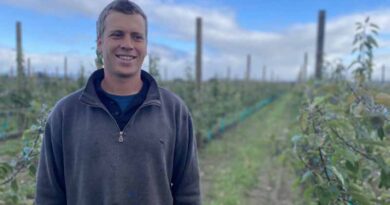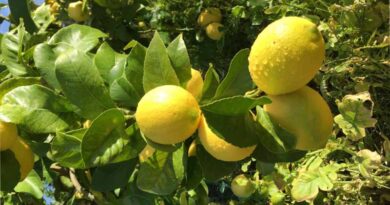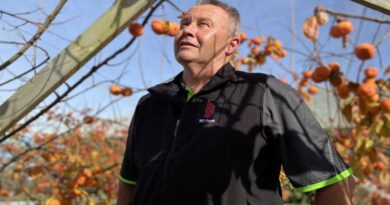Trellis-growing could be a ‘game-changer’ for citrus industry
15 November 2023, NZ: It was a case of pulling triumph from adversity when a Gisborne grower came across what she believes could be a game-changer for the New Zealand citrus industry.
There had been both hits and near-misses when Cyclone Gabrielle sent forestry slash and silt barrelling through Tam and Dan Jex-Blake’s orchard at Manutuke, 15 kilometres inland from Gisborne city.
Resoundingly hit were the more than 700 new seedless Eureka lemon trees they had planted over 1.5 hectares just a few months before.
But there was a near-miss for their next tranche of plantings, also seedless Eureka.
“We’d taken a block that had only ever had cattle on it and prepared it, had the GPS (geographical positioning systems mapping) done and booked the planting for 21 February of this year,” Tam explains.
“So when the cyclone came a week before, the young trees were safe, away from the flooding.”
Tam says that, as part of an aspirational land-use management plan set up by the recently formed Te Arai catchment group, it is up to commercial forestry further up the river catchment to help prevent future slash inundation.
Tam is presently chair of the Te Arai Community Catchment Group, recently established to address the widespread damage to growers’ properties caused by Cyclone Gabrielle. Tam is also deputy-chair of Rabobank’s Lower North Island Client Council, and a Board member of Growing Future Farmers. This month she also joined the Citrus NZ Board.
In the meantime, she and Dan were determined to do what they could to protect the citrus and Rockit apples at their Mangapoike Horticulture Orchard.
And they thought new variety development manager, Matthew Carter at First Fresh might have the answer.
Also on both the board and the research committee for Citrus NZ, Matt had the year before been to a conference in Australia where he had seen early trialling of trellis systems for citrus.
“I wasn’t sure how that would work in New Zealand but the concept was there, so I wrote about it for Citrus NZ’s quarterly newsletter,” he says. “Tam remembered reading that piece and called to say that could be just what they needed.”
Tam and Dan are two of around 100 growers looked after by Gisborne-based marketers First Fresh, whose chief executive Ian Albers was also intrigued by the idea of trellis-growing for citrus.
“So we talked it over and looked around to see where the most advanced, most successful trials were taking place,” says Ian.
“By May we had quickly pulled together a travel itinerary and the four of us headed to the United States.”
It was no tourist jaunt … the quartet made a bee-line for San Joaquin Valley, a major food-growing region in California’s vast Central Valley.
There they visited half-a-dozen trellis-growing orchards, ranging from fledgling trials to a near-decade-old operation.
“They were mainly working with dekopon (a variety of satsuma orange) but we did see a few lemons and there were various techniques in terms of how the trellising was used,” says Matt.
“Tam and Dan decided to take the best of what they had seen and carry out some additional research to come up with a method they believed would work in their own commercial setting.”
By early September the towering trellis structure was installed and the young trees planted, each snuggled in a bed of strong wool sourced from the Jex-Blakes’ sheep and beef station located further up the valley.
They also opted to plant on mounds, giving the new trees extra elevation to mitigate silt risk in the event of another major cyclone.
It is believed to be New Zealand’s first greenfield commercial citrus planting on trellis, and for Tam – who does most of the day-to-day work in the orchard – the advantage was not just support and protection for their trees.
It would also open the canopies to more light, increase fruit production, promote ease of management and pave the way to robotic harvesting.
As a clincher, the system also supports intensification: the four-metre-wide rows allowing planting of 1675 plants per hectare … significantly more than the 606 currently recommended for seedless Eureka lemons.
“There are costs associated with licensed products like the seedless Eureka lemons (for which First Fresh holds the New Zealand marketing rights) and with the installation of infrastructure like trellising,” Ian Albers says.
“But we believe the prospect of intensification, in addition to the creation of extra efficiencies, can offset that.
“We’re always looking for new ways of doing things and that’s why we’ve devoted so much energy to the idea at this very early stage.”
As the lemons get established in the trellis system Matt Carter will do in-house monitoring for First Fresh, with the support of industry bodies like Citrus NZ, but for the Jex-Blakes there’s nothing experimental about it.
“This is essentially a trial but we’re not just saying ‘we will make it work’, we’re also saying ‘this is how we are going to do it in the future’,” Tam says.
“The logic is compelling and we see trellis growing as being a potential game-changer for citrus in New Zealand.”
Also Read: Boosting Millet Production: ICRISAT Joins Forces with the Assam Millet Mission
(For Latest Agriculture News & Updates, follow Krishak Jagat on Google News)















